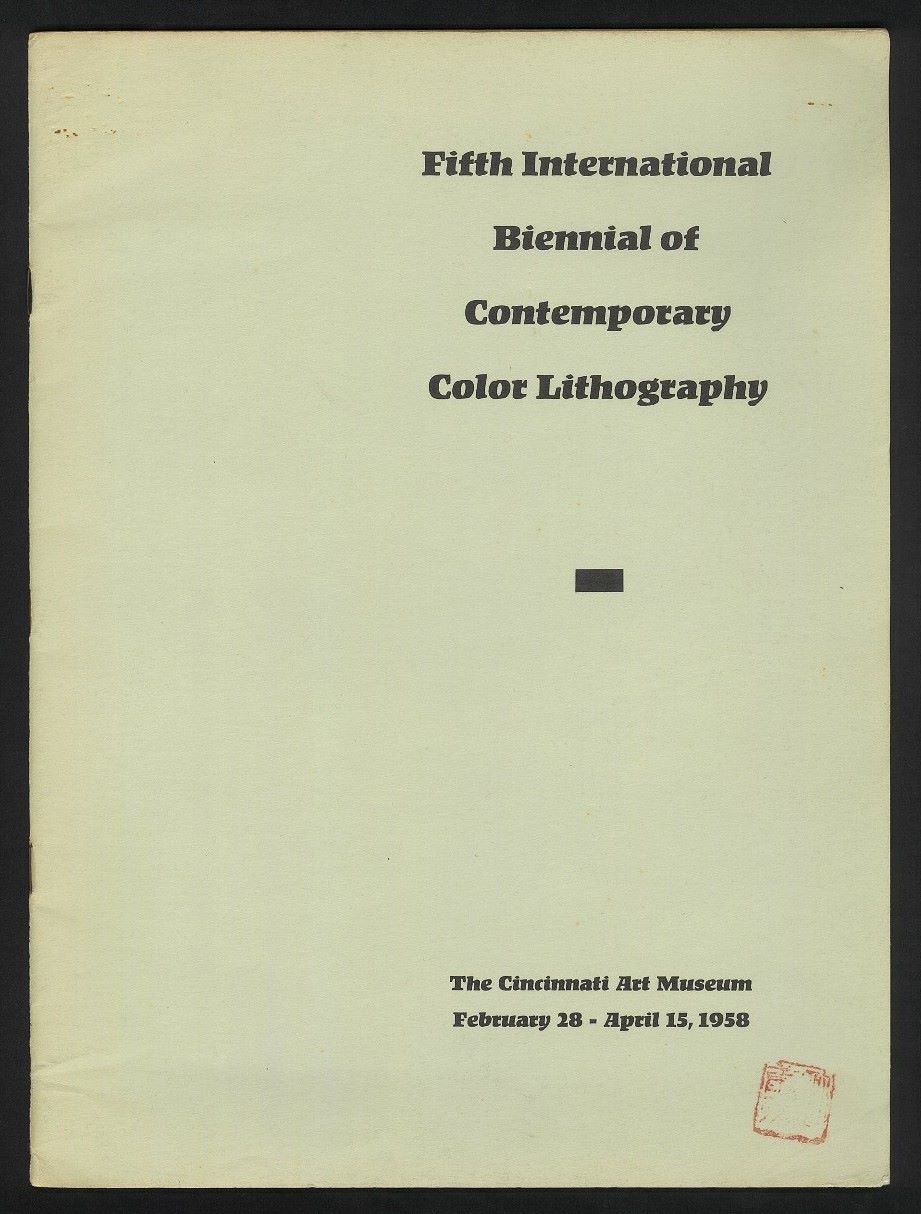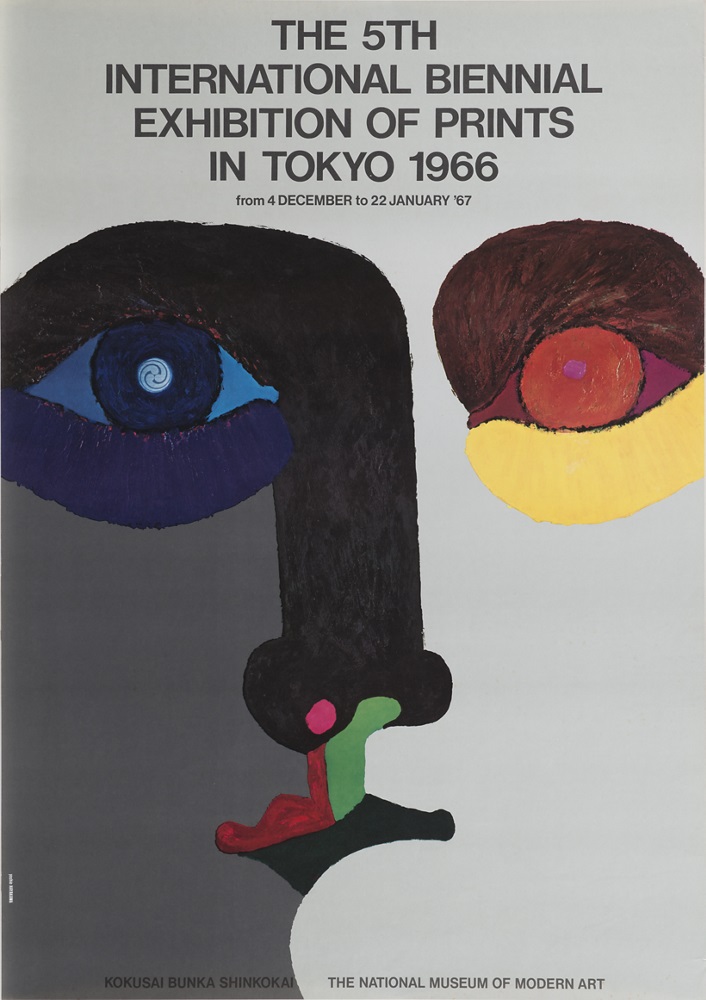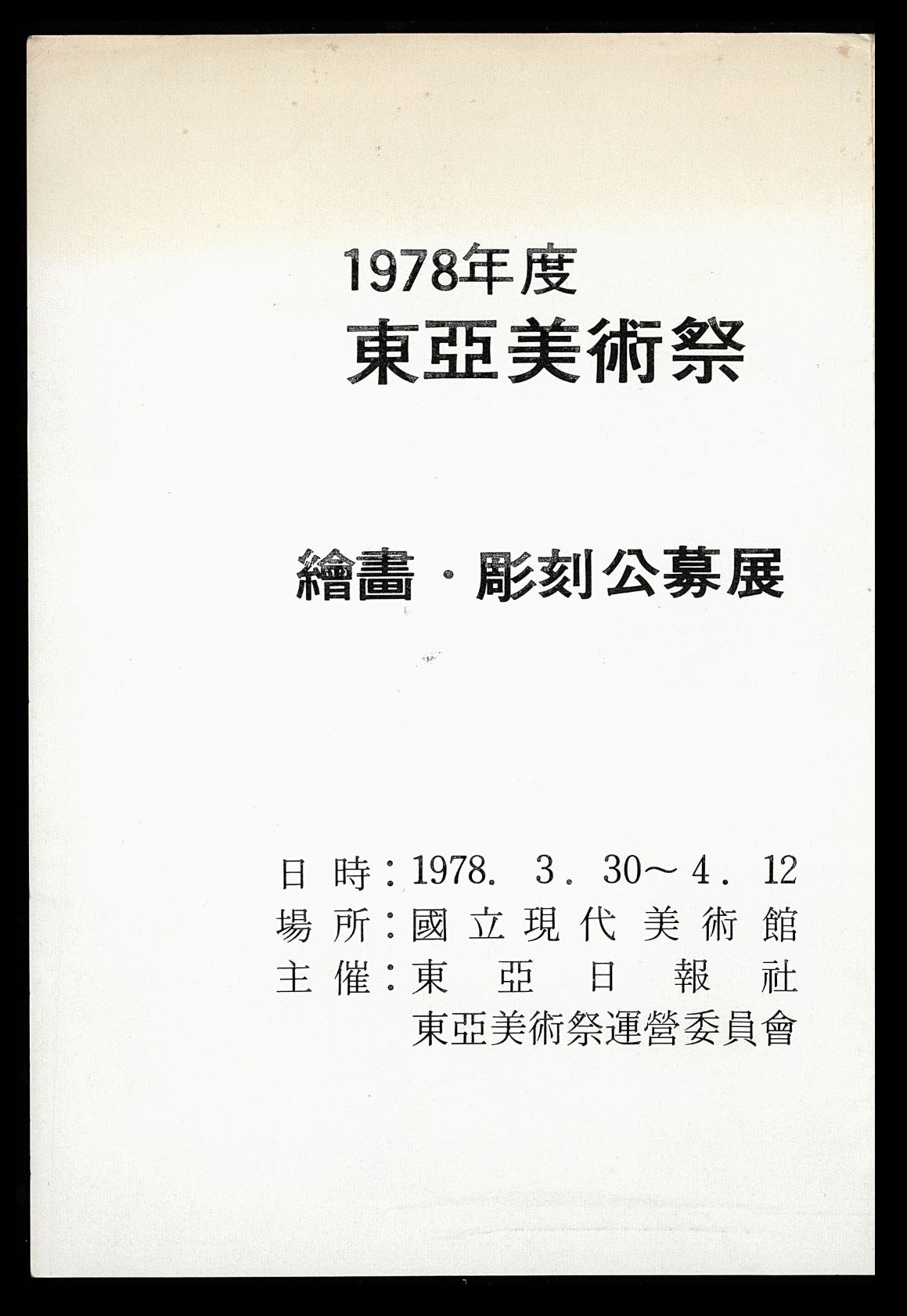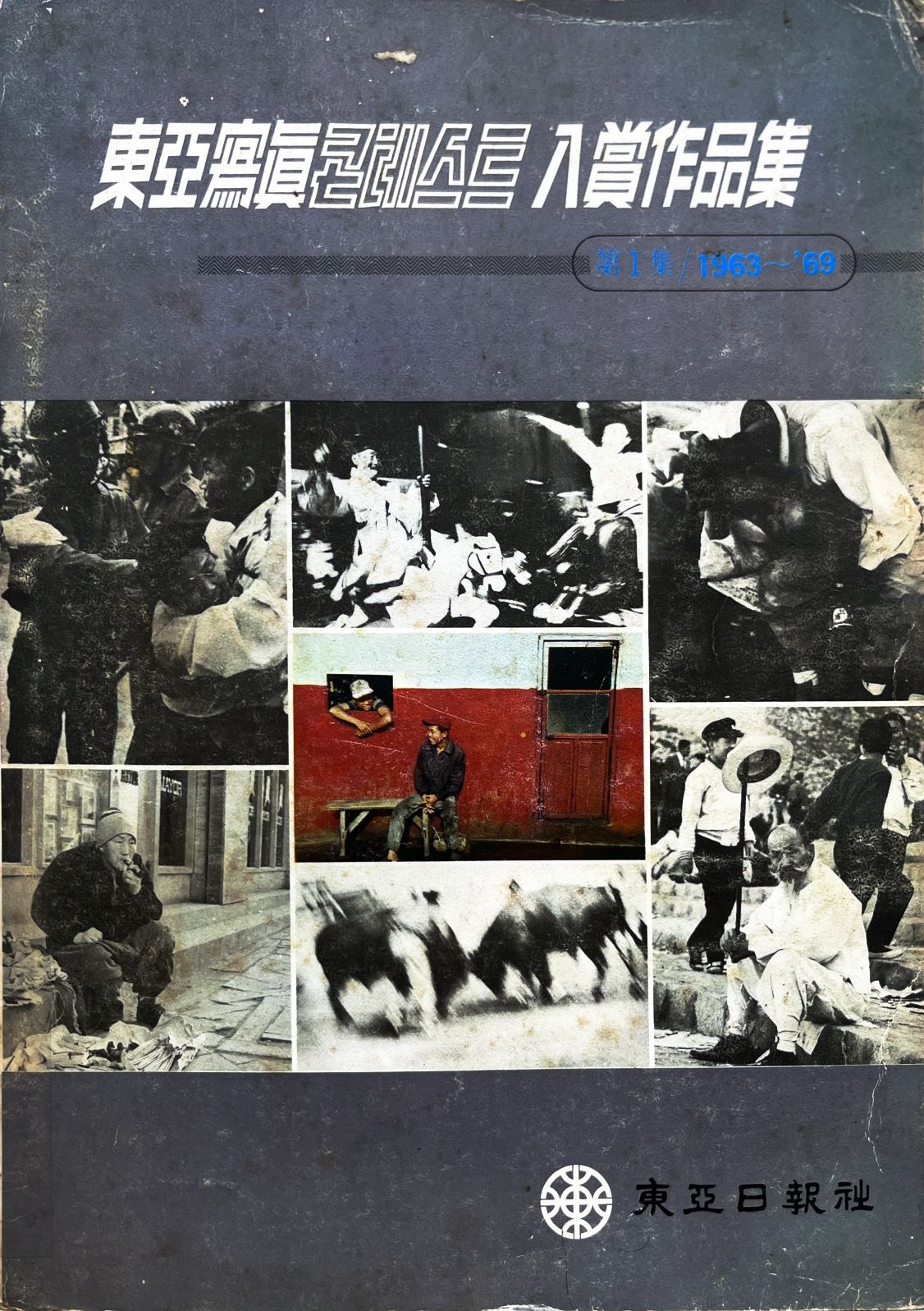
The First Seoul International Print Biennale, Catalog, 1970, MMCA Digital Library Collection
Seoul International Print Biennale
* Source: MMCA
Related
-

International Biennial of Contemporary Color Lithography
The International Biennial of Contemporary Color Lithography was an international print exhibition held from 1950 through 1960 by the Cincinnati Art Museum in Ohio in the U.S. At the time, there was a printmaking boom in the U.S. sparked by the relocation of Atelier 17, a notable Parisian printmaking studio, to New York in 1940. In the 1950s and 1960s, the International Graphic Arts Society (IGAS) was founded, and several special exhibitions on prints were held, including New Expressions in Fine Printmaking: Ideas, Methods, and Materials (Brooklyn Museum, 1952). In addition, institutions for exploring printmaking, such as Pratt-Contemporaries Graphic Arts Center, Tamarind Lithography Workshop, and Universal Limited Art Edition (ULAE), were built. Under these circumstances, Gustave von Groschwitz, a curator of prints at the Cincinnati Art Museum from 1947 to 1963, organized the first biennial of color lithographs in the U.S. Only works created within two years could be submitted to the biennial, allowing two prints per artist. Korean artists had participated in the biennial since 1958. Yoo Kangyul, Kim Choungza, Choi Dukhyu, Kim Sou, Rhee Sangwooc, and Lee Hangsung took part in the fifth edition in 1958. Their participation in the biennial led to the acquisition of some works by the Cincinnati Art Museum. They were Face and Pagoda by Kim Sou, Winter by Rhee Sangwooc, and Silhouette and Buddha’s Spirit by Lee Hangsung. This marked the first overseas debut of contemporary Korean prints. In the sixth edition held in 1960, Mountain Sentiment and Revival by Lee Hangsung and Study by Bae Yoong won prizes. Starting in 1962, the International Biennial of Contemporary Color Lithography was held as a triennial and renamed International Prints.
-

International Biennial Exhibition of Prints in Tokyo
The International Biennial Exhibition of Prints in Tokyo was an international print exhibition held in Japan eleven times from 1957 through 1979. Initially, it was co-hosted by The National Museum of Modern Art, Tokyo and The Yomiuri Shimbun newspaper company. In the fifth edition, the International Cultural Promotion Association (Kokusai bunka shinkōkai) replaced The Yomiuri Shimbun, strengthening the nature of cultural exchange. Over twenty-two years, a total of 1,317 artists (1,098 foreign artists and 219 Japanese artists) participated in the International Biennial Exhibition of Prints in Tokyo, with approximately 3,000 works submitted. The International Biennial Exhibition of Prints in Tokyo is one of the international exhibitions in which a large number of Korean artists took part. This is partly owing to geographical proximity, but active exchanges with Japanese art circles in the 1970s also encouraged their participation. Korean artists consistently participated from the fifth edition to the eleventh. Yoo Kangyul, Kim Chonghak, and Youn Myeungro joined the fifth edition (1966); Bae Yoong, Suh Seungwon, and Ahn Dongguk, the sixth edition (1968); Kim Tchahsup, Ha Chonghyun, and Lee Ufan, the seventh edition (1970); Kim Sangyu, Kim Tschang-yeul, and Kwak Duckjun, the eighth edition (1972); Lee Ufan, Kim Kulim, and Chung Chanseung, the ninth edition (1974); Lee Kangso, the tenth edition (1976); and Suh Seungwon, Shim Moonseup, Kwak Duckjun, Chin Ohcsun, and Lee Ufan, the eleventh (1979). Among these participating artists, Kim Chonghak received an honorable mention in the fifth, and Kwak Duckjun won the Minister of Education Award in the eighth. In the eleventh, Chin Ohcsun won the Minister of Foreign Affairs Award and Lee Ufan won the Kyoto National Modern Art Award. In the eighth, the art critic Lee Il participated as an international judge. The International Biennial Exhibition of Prints in Tokyo exerted a considerable influence upon the development of Japanese contemporary prints and played a role in anchoring prints in the postmodern discourse of “de-genre” and “de-media” in conjunction with contemporary art. Witnessing the interest in prints not just from Japanese art circles but also from the international art community through the exhibitions, Korean artists became more interested than ever in prints, which emerged as a major medium of expression in contemporary art. Since the 1970s, there has been a significant increase in the number of artists working in printmaking.
-

SPACE International Print Biennial
The SPACE International Print Biennial as an international print exhibition organized by the SPACE Research Institute Co., Ltd. (currently SPACE Group) from 1980 through 2011. Since 1975, the art magazine SPACE had awarded the annual art award the “SPACE Prize” with the aim of promoting and developing contemporary Korean art. In its fifth year, in 1980, the award was limited to prints and changed to an international competition, leading to the First SPACE International Print Exhibition. Such change was made since prints were a convenient medium for transportation, and another intention for the change lied in expanding the SPACE Prize internationally. The first edition was a great success with 758 entries from 258 people in twenty-eight countries. The three judges, Lee Kyungsung, Youn Myeungro, and Ōshima Seiji, selected five grand prize winners, eleven excellence award winners, and 163 people for honorable mention. Among Korean artists, Jang Youngsook received a grand prize, Han Unsung, Chin Ohcsun, and Lee Inhyeon won excellence awards, and forty-one people received honorable mentions. The exhibition was originally planned as a one-time event, but drawing keen attention, it was changed to a biennial from the second edition and has been held for thirty years. Eligibility was restricted to Korean artists, and the recognition of rising artists enabled the biennial to serve as a gateway to the Korean printmaking scene. The regulation limiting entries to small works within ten centimeters high by ten centimeters wide contributed to the biennial's early success. However, participation gradually declined as the exhibition failed to accommodate the trend toward large-scale prints. In 2002, its organizers sought to make changes by abolishing dimension restrictions and renaming it the SPACE International Print Biennial. Nevertheless, as the concept of contemporary prints changed and interest in the competition waned, the biennial was discontinued after the sixteenth edition in 2011.
Find More
-

Dong-A Art Festival
An exhibition launched in 1978 by the Dong-A Ilbo newspaper company and the Dong-A Broadcasting System, Dong-A Art Festival aimed to discover new emerging artists through the art contest. Along with the JoongAng Fine Arts Prize that the JoongAng Ilbo newspaper company started in the same year, it became firmly established as a doorstep for emerging artists in the 1980s and 1990s. This exhibition was in line with the Dong-A Photo Contest founded in 1963 by Dong-A Ilbo and the Seoul International Print Biennale founded in 1970. The fields of the Dong-A Art Festival kept changing. It had been held biannually with crafts, calligraphy, and photography separated from painting and sculpture. In the 1990s, in even-numbered years the festival held competitions in four fields including painting and sculpture, whereas in odd-numbered years it held competitions in calligraphy, seal engraving, and literati painting. However, school ties and personal connections through associations in the art world affected the judging process, thus undermining the authority of the festival. Moreover, as artists debuted through diverse means such as solo exhibitions, the Dong-A Art Festival changed from a call for works to a call for exhibition plans in 2006. Since then, a newly organized exhibition has been selected every year through a competition, attracting attention, but it was abolished in 2014.
-

Dong-A Photo Contest
Dong-A Photo Contest hosted by the Dong-A Ilbo newspaper company was founded in 1963 by Lee Myeongdong, a photojournalist at Dong-A Ilbo, in response to the delay in establishing the photography section at the National Art Exhibition (Gukjeon). While the photography section at National Art Exhibition, which was established in the following year, was more like a state-led exhibition, Dong-A Photo Contest was more of a private exhibition. By the 1970s, both of them had evolved into two of the leading photography competitions. Although Dong-A Photo Contest tended to favor realistically inclined photographs as its prize-winning works, it also embraced a variety of experimental forms, including narrative photography. As it was absorbed into the Dong-A Art Festival in 1978, it was held every other year from 1979 through 1989. Later, it was separated from the Dong-A Art Festival and held under the title of Dong-A Photo Contest twenty-seven times from 1991 through 1996. From 1963 through 1977, it was held at the Press Center of Korea Gallery, and in 1979 and 1981 it was presented at the National Museum of Modern Art, Korea (now MMCA). Among the notable prize winners are Kim Theresa (1968 and 1969), Yook Myoungshim (1974), and Cha Yongbu (1976).






